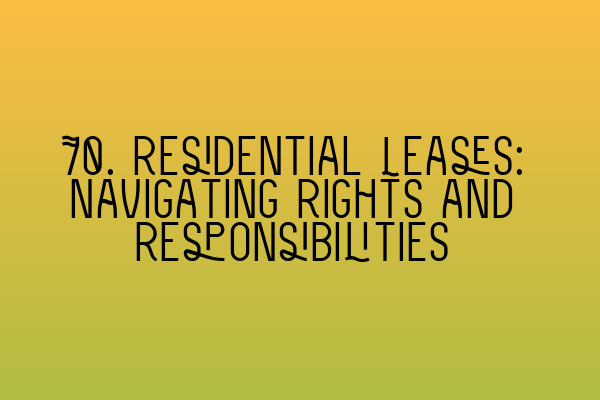Residential Leases: Navigating Rights and Responsibilities
When it comes to residential leases, it’s essential for both landlords and tenants to understand their rights and responsibilities. Whether you are a property owner renting out your investment property or a tenant looking for a place to call home, knowledge of residential lease agreements is crucial to ensure a smooth and mutually beneficial tenancy. In this article, we will explore the key aspects of residential leases, including the rights and responsibilities of both parties involved.
The Basics of Residential Leases
A residential lease is a legally binding contract between a landlord and a tenant that sets out the terms and conditions of their rental agreement. It outlines the rights and responsibilities of both parties and provides a framework for their relationship throughout the tenancy period. Residential leases typically cover important details such as rent, duration of the lease, security deposit, maintenance responsibilities, and much more.
One of the first things to consider when entering into a residential lease agreement is the length of the lease. Residential leases can be short-term or long-term, with the duration varying depending on the needs of both parties. Short-term leases, often known as periodic leases, are commonly month-to-month agreements that offer more flexibility for both the landlord and the tenant. On the other hand, long-term leases typically span several years and provide more stability and security.
Landlord’s Rights and Responsibilities
As a landlord, understanding your rights and responsibilities is essential to protect your property and ensure a positive rental experience. Here are some key points to consider:
1. Rent Collection: It is your right as a landlord to collect rent from your tenant on time and in the agreed-upon manner. Make sure the terms regarding rent payments are clearly stated in the lease agreement to avoid any misunderstandings.
2. Property Maintenance: Landlords are responsible for ensuring that the rental property is properly maintained. This includes addressing any repairs, maintaining the common areas, and ensuring that the property meets all health and safety standards.
3. Tenant Screening: Before entering into a lease agreement, landlords have the right to screen potential tenants to ensure they are reliable and financially capable of meeting their rental obligations. Conducting background checks and verifying references can help you select the most suitable tenant.
4. Property Inspections: Landlords have the right to inspect the rental property, usually with prior notice, to ensure that it is being properly maintained and to address any potential issues or damages.
5. Eviction: In cases where a tenant fails to comply with the terms of the lease agreement, landlords have the right to initiate eviction proceedings. However, it is crucial to follow the proper legal procedures to avoid any potential legal disputes.
For a more comprehensive understanding of a landlord’s rights and responsibilities, you can refer to our related article SQE 1 Practice Exam Questions.
Tenant’s Rights and Responsibilities
Tenants also have certain rights and responsibilities to adhere to during their tenancy. It’s crucial for tenants to be aware of their rights to ensure a fair and comfortable living arrangement. Here are a few key points:
1. Rent Payment: Tenants have the responsibility to pay rent on time and in the agreed-upon manner. It is essential to budget accordingly and communicate with the landlord in case of any financial difficulties.
2. Property Care: Tenants are responsible for maintaining the property and keeping it clean and in good condition. This includes promptly reporting any damages or maintenance issues to the landlord.
3. Compliance: Tenants must comply with the terms of the lease agreement, including any rules and regulations set by the landlord or the property management. This may include pet policies, noise restrictions, or restrictions on alterations to the property.
4. Notice Period: Tenants must provide the required notice period when moving out of the rental property. The notice period is usually stated in the lease agreement and varies depending on the terms of the contract.
5. Deposit Protection: In many jurisdictions, landlords are required to protect the tenant’s security deposit in a government-approved scheme. Tenants have the right to have their deposit returned at the end of the tenancy, provided they have fulfilled their obligations under the lease agreement.
To delve deeper into a tenant’s rights and responsibilities, we recommend reading our related article SQE 1 Practice Mocks FLK1 FLK2.
Conclusion
Residential leases play a vital role in establishing a fair and stable relationship between landlords and tenants. By understanding the rights and responsibilities outlined in the agreement, both parties can ensure a smooth and harmonious tenancy experience. Whether you are a landlord or a tenant, it is crucial to familiarize yourself with the terms of the lease and seek legal advice if needed.
If you are interested in learning more about property law and land law, check out our related articles:
Feel free to contact us at SQE Property Law & Land Law for any legal assistance or advice regarding residential leases. Our team of expert solicitors will be happy to assist you.
